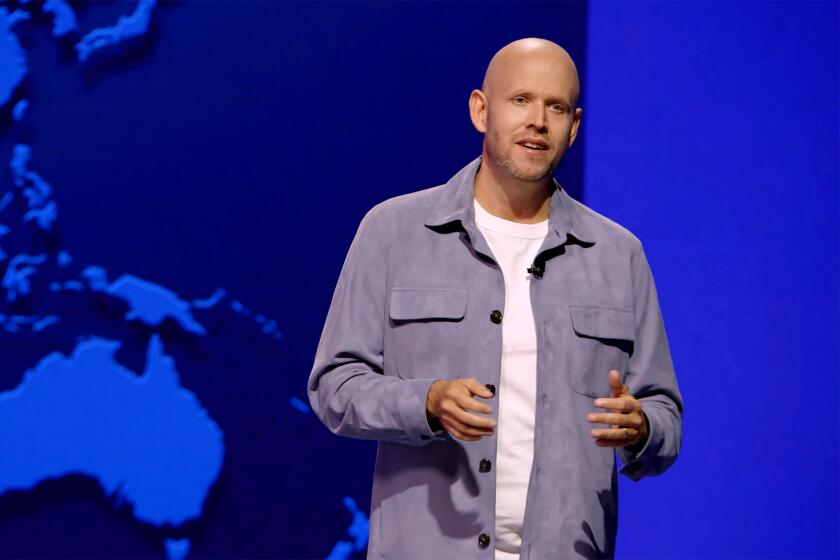Portable but posh
- Share via
Talk about a royal flush.
Step inside the cushy portable restroom built by Wisconsin’s Kohler Co., and you’ll encounter blasts of air-conditioning, a stereo playing New Age music, gold-plated faucets, designer cabinets, and a bank of private stalls with solid cherry doors, full-size flush toilets and framed artwork.
If that’s too low-rent for your tastes, Kohler can add a whirlpool bath, steam room, waterfall shower and crystal chandeliers.
“Why should you have to settle for a lesser bathroom experience when you’re away from home?” says Jeremy Knopow, general manager of Kohler’s “mobile plumbing” division.
Although the posh privies aren’t likely to show up at construction sites or outdoor rock concerts, they’re increasingly popular for weddings, corporate galas, golf tournaments and other glitzy events.
Andy Gump Inc. of Santa Clarita, which helped pioneer the portable restroom industry in the 1950s, says luxury latrines now account for a third of its business. “We’ve had them at the U.S. Open in Pebble Beach, aboard an aircraft carrier that went to Honolulu for the premiere of ‘Pearl Harbor’ and at one of Jennifer Lopez’s many weddings,” says company President Barry Gump.
The advent of pampered potties came about a decade ago, says Bill Carroll, executive director of the 630-member Portable Sanitation Assn. International, a trade group headquartered in Minnesota.
The initial purpose was to make the units more appealing to women. “A guy’s mentality is any old bush will do,” Gump says. “But women use restrooms differently.” Or not at all.
Industry officials began noticing that women were departing outdoor events early -- and taking the entire family with them -- to avoid dealing with the notoriously squalid plastic water closets.
The first upgrades involved adding solar-powered lights, sinks and running water. Companies also introduced waste-treatment chemicals scented like bubble gum, lemon, peppermint and “mountain breeze.”
From there, things escalated. Today, Gump maintains a fleet of 60 trailer-sized restroom “suites,” which rent for $3,000 a weekend, and feature such amenities as simulated hardwood floors, fresh flowers, faux marble vanities, swinging saloon doors for each urinal and black-tied attendants.
More flourishes are on the way, including canopied entrances and Art Deco-style furnishings.
The ultimate commode on wheels -- at least for now -- is Kohler’s behemoth Executive Restroom, which starts at $85,000 and debuted recently at a trade show in Sacramento. Weighing in at 13,000 pounds, the 32-foot-long forest green trailer is outfitted with cork floors (so golfers can use it without removing their cleats), beveled-glass mirrors, thermostat-controlled climate system and hand-painted porcelain sinks.
And that’s the cheap model. Kohler also offers drivable cabanas (built onto a motorized bus chassis) with such options as saunas, skylights, showers and couches. Prices can climb as high as $250,000, Knopow says, noting that the company plans to sell the fancier units to rock stars and athletes for private use, whereas the $85,000 econo-models are for large groups.
“If you’re at a wedding or other luxurious event where everyone’s dressed up, your bathroom should match the tone,” he says.
But that can backfire. “I’ve heard about weddings where the guests talked more about the luxury restrooms than the bride,” says Phil Dunne of Advanced Containment Systems Inc., a VIP toilet manufacturer in Houston.
Such praise is welcome news for the portable sanitation industry, which has long been plagued by image problems.
The history of mobile restrooms goes back centuries, says Ronald Barlow, author of “The Vanishing American Outhouse.” Renaissance painters sometimes depicted “outhouses on wheels” in their landscapes. Before that, entrepreneurs armed with chamber pots and large cloaks served as walking bathrooms.
In modern times, the first porta-privies were reportedly built for shipyard workers in Long Beach during World War II. (Another account says movie studios developed mobile wooden restrooms in the late 1920s for film shoots, but that claim is disputed by Carroll and Gump, who say the Hollywood johns were stationary outhouses placed over pits in the ground.)
Today, spurred by such advances as the “hover handle” (a grip on the inside of the restroom door that users can hang onto to avoid touching the toilet seat) and Soy Blasters (an “environmentally friendly graffiti remover derived from U.S.-grown soybeans and corn”), the number of portable toilets has swelled to 1.4 million worldwide, according to the Portable Sanitation Assn.
Construction companies are the biggest clients. But special events are growing in importance. Organizers of the Winter Olympics in Salt Lake City ordered 2,300 units, some of which required electric heaters installed underneath to keep the equipment from freezing. The biggest single deployment of mobile johns was in Toronto in July -- 7,500 units for the pope’s World Youth Day.
To calculate how many portable toilets are needed for an event, planners rely on a formula devised by University of Missouri researchers, based on the number of guests, length of the event and availability of alcohol (if booze is served, the number of toilets required jumps 40%).
Despite the academic studies, mobile latrines still don’t get much respect. Portable restrooms remain the subject of countless jokes, even within the industry, where companies go by such names as Nature’s Call, the Mother Lode and Dear John -- or advertise with slogans like “No. 1 in the No. 2 business” and “We’re your solution to human pollution.”
In response, Carroll’s organization has formed an image committee to promote “a positive attitude and pride in what we do.” But it’s an uphill battle. “I went to a trade show in Nashville not long ago, and one guy was walking around with fake dog poop on his hat,” he sighs. “What kind of message does that send?”
Weird hats aside, being in the portable lavatory business does have its glamorous side.
In 1976, after Ronald Reagan lost the Republican presidential primary to Gerald Ford, he threw a thank-you party at his ranch and rented some restrooms from Gump. “When I got there, he helped me unload the units,” Gump recalls.
Since entering the luxury loo market, Gump employees have been invited -- with their restrooms -- to movie premieres, a presidential library dedication and celebrity soirees.
“I’ve been to Mel Gibson’s house and I personally saw him go into one of our suites,” says Gump’s daughter, Nancy, who runs the company’s special events division.
It’s quite a change from the company’s humble beginnings in 1956. Founder Andy Gump, who died four years ago, built his first five units out of used plywood in the garage of his Mission Hills home, after Los Angeles enacted a law requiring portable restrooms at construction sites.
At the company’s North Hollywood warehouse, on a patch of cement behind the fleet of luxury trailers and solar-powered VIP cabanas, son Barry keeps one of the rustic, cobweb-filled plywood johns. “My brother and I were in junior high school when we helped my dad build those first five units,” he explains. “I don’t want us to forget where we came from.”
More to Read
Inside the business of entertainment
The Wide Shot brings you news, analysis and insights on everything from streaming wars to production — and what it all means for the future.
You may occasionally receive promotional content from the Los Angeles Times.










